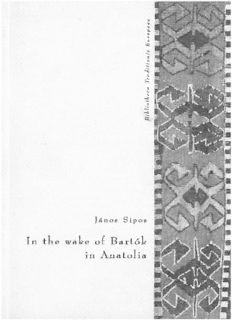
In tke wake of Bartók in Anatolia PDF
Preview In tke wake of Bartók in Anatolia
János Sipos In tke wake of Bartók in A n a t o l ia János Sipos In the Wake of Bartók in Anatolia European Folklore Institute Bibliotheca Traditionis Europeae Volume 2 Edited by MIHÁLY HOPPAL János Sipos In the Wake of Bartók in Anatolia European Folklore Institute Budapest 2000 Sponsored by Ministry of National Cultural Heritage of Hungary My expeditions were supported by the Stein-Arnold Exploration Fund of the British Academy, the Soros Foundation and the Tokyo Foundation. The CD was prepared with the generous help of the Turkish Republic. English translation by Judit POKOLY Translation revised by Aino PAASONEN CD compiled by János SIPOS © European Folklore Institute 2000 © János Sipos 2000 "Folk music is a phenomenon of nature... Tliis creation develops with the organic freedom of other living organisms in nature: flowers, animals, etc. That is why folk music is just as beautiful, just as perfect. It is the embodiment of the pure musical thought that astonishes us with the conciseness and expressiveness of form and the wealth of tools on the one hand, and with its freshness and directness, on the other. " (Béla Bartók, A népzene forrásánál [At the source of folk music] In: Muzyka 1925, vol. II, no. 6, pp. 230-233.) Contents INTRODUCTION 9 BÉLA BARTÓK'S TURKISH COLLECTION 13 ABOUT MY COLLECTION IN ANATOLIA 25 PRECEDENTS 25 MY FIRST COLLECTING TRIP IN TURKEY 28 FOLK MUSIC IN TODAY'S TURKEY 36 ABBREVIATIONS 43 ANALOGIES BETWEEN ANATOLIAN AND HUNGARIAN MELODIES... 45 REALIZATIONS OF THE SO-(FA)-MI-RE-DO NUCLEUS AND THE RELATED TUNE TYPES 48 TWIN-BAR TUNES OF (SO)-MI-RE-DO CORE 48 Twin-bar tunes ending on do 48 Twin-bar tunes ending on re 52 Twin-bar melodies with mi finals 54 Similar twin-bar tune types of other peoples 55 HUNGARIAN AND TURKISH LAMENTS 57 Hungarian laments 58 Anatolian laments 60 Anatolian laments built from one musical idea 60 Anatolian laments built on two musical ideas 66 Single-core Anatolian laments with cadential descent 73 Anatolian laments with two musical ideas and a cadential descent 76 Strophic tunes developed from the lament 80 Anatolian laments in minor and Phrygian modes 82 Large forms developedfrom the small-form of the Anatolian lament 87 International relevances of Hungarian and Anatolian laments 93 THE HUNGARIAN AND TURKISH PSALMODIC TUNE STYLE 96 Hungarian psalmodic melodies 96 Anatolian and Hungarian psalmodic tunes in a low register 100 Turkish and Hungarian psalmodic tunes moving in a higher register 105 Psalmodic tunes based on two musical ideas 116 Psalmodic tunes in Béla Bartók's collection 119 DISJUNCT TUNES 129 Lower fifth-shifting Anatolian tunes 131 Tune class of 5(5)b3 cadences and AAAcB form 133 Fifth-shifting Anatolian tunes of major mode 136 Tunes with 'special fifth-shifting' 138 PARLANDO MELODIES WITH LARGE COMPASS 139 MELODIES WITH SEQUENCES 145 Descending sequences of bars 146 Sequences of lines, parallel lines 150 OTHER HUNGARIAN-ANATOLIAN MUSICAL ANALOGIES 153 Tri- and tetrachord tunes 153 Hungarian analogies to narrow-compass Anatolian tunes 154 Four-lined Anatolian and Hungarian melodies 165 Unique melodic outlines and scales in Anatolian folk music 166 Anatolian tunes of architectonic construction 168 TURKISH-HUNGARIAN CONTACT IN THE COURSE OF HISTORY 171 TURKIC RELATIONS OF THE HUNGARIANS 171 THE ETHNOGENESIS OF ANATOLIAN TURKS 173 THE INFLUENCE OF NEIGHBOURING PEOPLES UPON ANATOLIAN FOLK MUSIC 176 POSTSCRIPT 177 TEXTS AND THEIR TRANSLATION INTO ENGLISH 179 ABBREVIATIONS, REFERENCES 215 Introduction While the comparative linguistics of Turkic peoples has reached a high level of scholarship, comparative ethnomusicological research into the music of Turkic peoples lags far behind. No monographs indispensable to comparative analy sis have been written, and attempts at tune systematization and comparative investigation are also often missing. This is so though the question of whether the folk music of different Turkic peoples and of the Hungarians have features in common deserves general at tention. Just as important would be to establish what the possible coincidences can be attributed to. It is imperative for Hungarian ethnomusicology to get an insight into the old strata of Turkic folk music, for it is known that some Turkic ethnic groups played a salient role in the emergence of the Hungarian ethnicity, Hungarian culture and folk music. It is no wonder then that Hungarian researchers have played a leading role in the comparative examination of Turkic and Hungarian folk music. Béla Bartók, from relatively little material, reached some conclusions still valid today about the folk music of the Volga region and Anatolia,1 Zoltán Kodály extended the analogies by studying the folk music of Cheremiss and Chuvash people.2 On the basis of an immense collection from field-work among Cheremiss, Chuvash, Mordvin, Tatar and Bashkir peoples, László Vikár de scribed these musical traditions.3 From a study of publications, Lajos Vargyas established a historical outline of the folk music of the Volga region.4 Having studied an immense amount of material, Bence Szabolcsi demonstrated even 1 Bartók (1931, 1976) 2 Kodály (1937-76) 3 Vikár (1969, 1979, 1982, 1993), Vikár-Bereczki (1971, 1979, 1999) 4 Vargyas (1953, 1980, 1981)
Description: